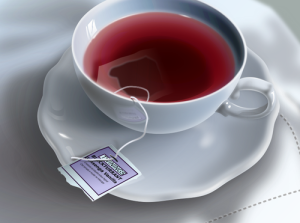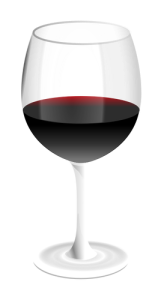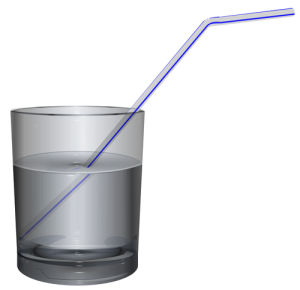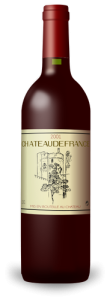1 Section 4-1: Quantities of Measure, Weight, and Number
Quantities of Measure, Weight, and Number
In chapter 3, you learned modal verbs. One of these, möchten (would like), is useful when ordering in a restaurant or buying things in a store or market place. It’s as easy as filling in the blanks of the following phrase:
“Ich möchte ______________.”
Ich möchte eine Pizza mit Käse und Salami.
(I would like a pizza with cheese and salami.)
Below is a chart of the conjugation of möchten. If you need a review of the other modal verbs, you can find them in Chapter 3 of German 101.

However, if you want to buy certain quantities of these items, you need a few more words. Note the words for quantities in the conversation below.

- eine Tasse Kaffee—a cup of coffee (literally “a cup coffee”)
- ein Glas Cola—a glass of coke (literally “a glass coke”)

Here are a few more that you might order in a restaurant or market place:
- ein Liter Milch
- eine Portion Pommes
- eine Flasche Wein
Notice that, although we used the word “of” in English, such quantities do NOT use a German equivalent of it.

(Audio courtesy of Galaxy151, Creative Commons Attribution-ShareAlike 4.0 International).
If you want to order two or more of something, the same rule applies—don’t use an equivalent for “of.”


Here is where you will need to make note of a few differences concerning quantities in German:
- Nouns of measure that are masculine and neuter will remain in the singular after noun phrases of weight and measure
- drei Glas Bier; looks like „three glass beer” (das Glas but die Gläser). We write “Glas” in the singular because it is neuter.
- zwei Stück Kuchen; looks like „two piece cake“ (das Stück but die Stücke). We write „Stück“ in the singular because it is neuter.
- vier Liter Benzin; looks like “four liter gas” (der Liter but die Liter). We write “Liter” in the singular because it is masculine.
- zehn Kilo Gurken; looks like “ten kilo cucumbers) (das Kilo but die Kilos). We write „Kilo“ in the singular because it is neuter.
- Nouns of measure that are feminine will be written in the plural as always.
- zwei Tassen Kaffee (die Tasse, die Tassen)
- drei Flaschen Wasser (die Flasche, die Flaschen)
- fünf Portionen Currywurst (die Portion, die Portionen)



Video. Click to see me reteaching this. (Disregard the page numbers; they’re from a different book.)
Warm up with Claudia Kost’s and Crystal Sawatzky’s (University of Alberta) quantities of measure activity:
Ex. A: Im Restaurant. Sie sind im Restaurant und bestellen die folgenden Sachen.
Beispiel:  (2)
(2)
→Ich hätte gern zwei Tassen Kaffee.
ODER
→Ich möchte zwei Tassen Kaffee.
 (1)
(1) (3)
(3) (2)
(2) (1)
(1) (5)
(5) (2)
(2) (1)
(1) (3)
(3)
KULTURECKE: Döner have become a fastfood favorite in Germany. Watch Deutsch im Blick‘s video of two students ordering Döner. Wie oft essen sie Döner? (Used with permission from The University of Texas at Austin | coerll.utexas.edu.)
Ex. B: Rollenspiel im Restaurant. One partner plays the role of the waiter/waitress. The other plays the customer. Complete the following tasks. Then switch roles and do it again.

Want some more alternatives on how to order drinks? Watch Easy German’s video to learn more.
Advanced video. Watch Easy German’s video to see more advanced phrases on how to order food via telephone.
Ex. C: Nicos Weg. Episode 27: Sofa, Sessel und Tisch. Watch episode 27. Then do the online activities. You will review rooms of the house, which you learned at the end of Chapter 3, and how to make compound words, which you learned in Chapter 1. In addition, you will learn a few new words for furniture.
https://learngerman.dw.com/en/sofa-sessel-und-tisch/l-37438475

Want a visual list of these words? Go here to the picture dictionary.
QUICK LISTENING PRACTICE: Listen to Anke (AudioLingua) talk about her apartment. Which items and rooms do you hear her mention?
- Zimmer (rooms):
- Möbel (furniture):
In Chapter 2, you learned the accusative case. The accusative case is used for direct objects. For example, if you wanted to say, “I have an armchair,” you would put “armchair” in the accusative case because it is the thing being had, i.e. the thing getting the action of the verb.
Ich habe einen Sessel.
Since Sessel is masculine, we add an extra –en to the end of the article. To review the accusative case, you will use the new words learned in the previous exercise to describe what items you have in your house.


Ex. D: Mein Haus. Was haben Sie zu Hause? Beschreiben Sie Ihr Haus.
Beispiel: Ich habe ein Schlafzimmer. Ich habe ein Bett und zwei Stehlampen. Es gibt einen Fernseher und ein Bücherregal. Ich habe kein Sofa…usw.

ADJECTIVES Review: Don’t forget about the adjectives we learned in chapter 1 last semester. Try this review to keep them fresh. (Courtesy of Claudia Kost & Crystal Sawatzky, University of Alberta.)

